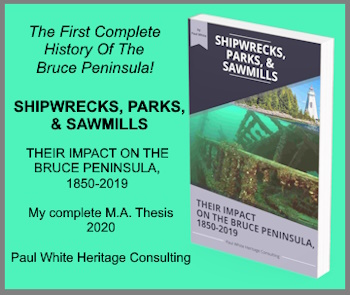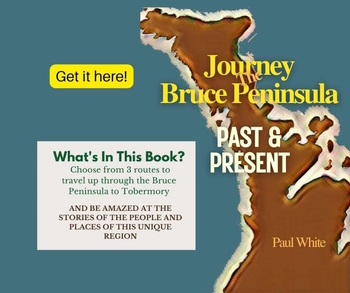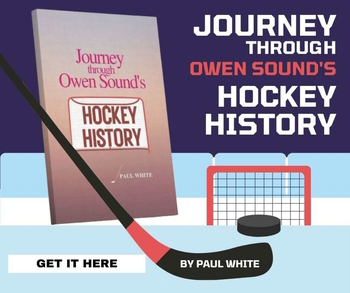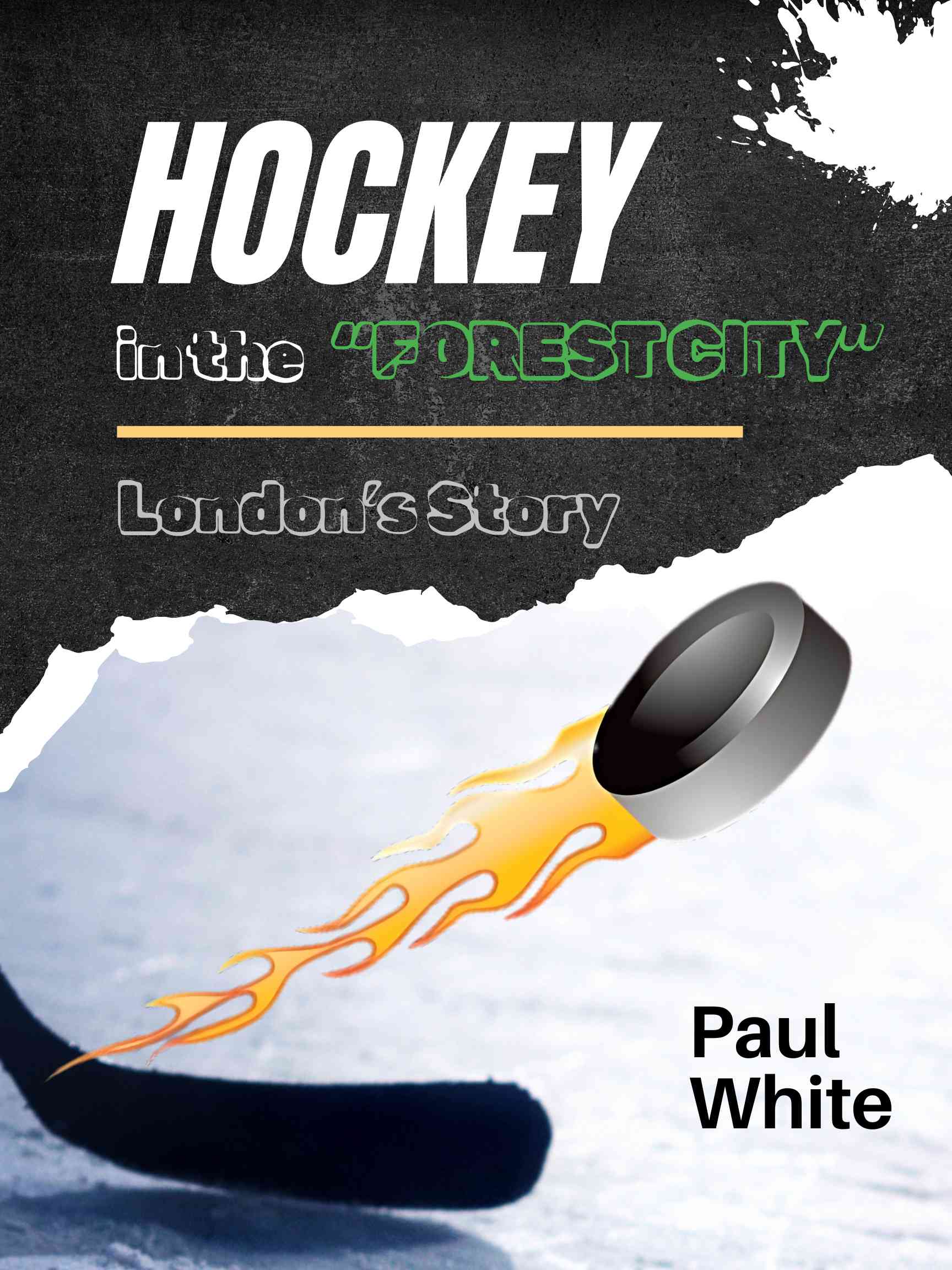Menu
- Home
- Contact
- Books
- Bruce Peninsula
- Georgian Bay
- Hockey
- Owen Sound
- Bruce County
- History Pages
- Aboriginal
- SUBSCRIBE
- SHOP
Please enter the Password.
53616c7465645f5fc9c0396d097bf7ece49b4b2cc6bd9fcfd57b598030c052eb9c171c024e6e21ac5cd609d0502583067b35a491fd2e15afd42ab28602c9eef6f31e958149696c568fd728dec081a7cb9b2e15f262d7c5b62d35e989245ba653be6c35552e8a85c337d1cea779be8dc42aef11cb1e11c6f727f7ed160ea0028167a89041bfed5c152528afdb5f7af4741225b546828d4d9e48bdcff63057a92bd99fb9e0ec7cbdfdb1475fc902b54e26d3f23651fd9c3bf23f2fe1c2b1cb3398e69bd7d363981ddbc9a08c5659eb5ed520524b57d215597bf791f1301d70d589855f668bd84446ba4679e76332ef4453a82c3464afe2262a12f7c3831caba8e5069dfc4ab548b1a9258873dd3e9d77076dfa365fd94ddf3df11fbff565b79d5f3ef3d312f2573ef298b9e2e235c0bf7ac551fa8a84beb423ee2d03539fd285e4a3ebbee49806f4d09c90a5246af9b8615e4f5831a428b949f9a1c54d0753f62dbe401a566570b7745214effc9b66d3376a540024b54fc9d418cecf7318a40dbf58dc0656350e4c6f37d2cab5fb1a6abe3a4ed482604bc2801a76bb1b8c23879524c95be8b797e34072a07fb50ea4a34a2677dfe7c5a95482a191864ee4e87c9df399052d1f3e474ef5ab654bd49698bea82965d1d228fc8fb763e82f97b10507a5dc9e57498ea7ebfe7d22bdb9064b50aba37988732f4b1c8b3aba52fda2ed36854b55ae0bfab16fe7dcf77d22d7b4ab45b22fa497754f10d939138d880dbc4b0f4748cb0f76f582c4ae2254d0e87e11e89405b9dcfdc6cece4928c2e49f7c94eac1704f87d57204f3013f9c380b01409428c10d862e5d294cc8d711f6027685ef5df7bc4f297f0ef8eddc7c183e814088c904acdadf65a2828553fc65afc609f100e2e1aaaf8816abcf956cf14e84afb2dd320cc7bbd9f5d624d4d44b2ab516ef7b4e35ab8f23ff4dcff71aa3ab202b9594ed30b8068c23460dda6382f36b0e024f0e1052b5cfac0349f18506565d0ec8694444274fe7dac440235de4a401742853f0efb6a7dd7f222a786492728ec9d2dda01b38d982162c7d192ad54a680c1b8f409a054664eddc22a882d6aa37e99c8f2acb9219c76a9e13b5e022589ce5847ee780c59d4b543780cb16ec81cd38f0d3d38bfe7d96b336b9fba61bc4a033413af7f4d1df1d5de159c21dae9f5c5700f16ff08759bf80485781addc3ea3d64ad086b3d5e3299f72c8293d3863ff8bfa0693bd0ae645b4181de3aa1a89f09d0ea4ce5248bd44e66656b806b2e70b434d7ed45ec0c3ac7cb1665f89a7f53a3ed0bb384e88ba2bd9a301a85322ce66e2367d0227de25aadc67c34c722d70c9a2694cca94b3b242735ef24330c0b931390aa2e1b33497dfc4ca910889b2e8bda8daa59d7ec5f13652b8f8e981f2e20352f20eb1f0d78346c8945be26c2c8fc67ab2212eb1158999c4b9732568f3c0319a492503ea164c8bf88026b7a8be68a7840d5e7a01746768b761df2b6f66b455c27851bdc8b4b7d168becded01fdbd376c9996c5f6e0e510f3e5ebb9cf4e1ce3ed18c2fb177bdb5b82ce19d9572ac02d4c5a8823cfcf5785437a031064a2359cdfe05a4c65f32ca252a4edd543199474bf810da2da9ca8bf279d1c29aeaef49ae8261c891a979907f0ef0705c0d2266f754a7b9769150560b62fb3eae62762b090ee60b8dda6aac7e867fb3dd18835d43d84bb8f3c3d8188f7e3d2fcdc3ec894d6d64c0a622f1ece8d4dfabbef5082bfa74552222ecb1ae2daf792b45ce95b72d1b583b5c7fc259e21c63cf8073f1b7de76fee7fff8fbf937428e7e76a58653351787b07ab5ba34cf07ae30fbd2336e671caf9b890af0b21b1a53ec2400a200cd8ab34568970f9ffb827087f33dd52e9e5ab801050deb298810ab8f631e4a3a7a9f7323c08e1af1743489539703a54fcb83af47e9b4e9d52c087165695f771ff962675df382396fa2f9083dba74bebc8ccf1f9df2d9dfbf9c9c4a56e5b37774f5840db0767654df3d95000758e6c23058565fe3bbebdb9b5d3046555cf98d7c20b72b4f6fa03a6062eb217e66d467c2f977ae3e16634d7283ba11be1873304abe6e98ff6486fa8171b5ff6ca81e3fbf84ea1fecf4c61d0456915527af137e8ebaca920342b0fb93504964adfaa40fb35882b9ec5d48103c8d63ed5973922aebcb89484abc7ef7e64b6cbf8eb0b9ece00e281030204c5f0c1c099ab0e0bbaa1e8ec2b91f63695fd0ffafad29820abb24ab01129d1dbaf06961433e1020fbf85a453a9f12bf65f2e378241e4643c3c4897bac70f98cbe8393f839a4e369be511924fafdb62a92522e21ae211cc88b1c87fb6e6b9b182c11df3a116a2944d54b42ee6633c5f7d9f03fc0a85b85ad9d19f540b852a23d32db11adcf3b880dc12e85cd8dff9931744a550e5a387ff78a4f19de156dc070e87fd95ce1c437c4e424768915842301a43906a1e0e7cff10a749f382888b47032138ab1589b96236b712c7bdb805c2657d11621a30e17669356870bd87c92845f91551f39e34b74e783b1216c8558852e5a2e67c2a3ad3fa22f5518010927ff8e28e9778e65ca3ee7eb359365b90690490284f7b0c995104c1e821e119a41cb72a4149fdb4da0b6f1c6c2e3c8133603400e30e09513d0bffd481a9218f78194c9923bf43efce48f592426bd7c76abdac00ade99dbf5721b1e49d74fc7bce8347c85ed36d085553ac90b4adebd96aa9c95ed698fd07914cfb1e730d793b3152997812a9d7d993c4c7831b9f036b33bf2e496001c11d3d4714b183523f9a9ac8b2c1977546b192c5c5718d1060ec8201ddb137b611f63c94ee5a7c7f9dbb09f82ab169db09cc4d4b9df68cd82e85da5be29ea2dadb33e218e00d98d56b4a617a917b8549dc3706b8f956c21a5ef127afc2fbdb0861e3185078aadfa8c0b917c39f3256c90d8182390c80bfc19aca2efb62cfec84121d069eae8926f0a57895ae10770a7e7ddad177b03eda7a56150087f910f4b485ef2ff46c093f4521434df713e44892efc222b8426466ee5a64e64dde28db1bf5e3988c15046755e5ae1a4c29e257e38beeaf780854d71cd950471055190fdc41113377fff6e2fdeffbdc561e15cbdf533066edb250bb04466048e9906dc1e8cffa2e96d0e0836b7bdd783c5f096ec4092322a4689dddbecd0f69e740b3ac172ed64bd91d04ebb3239259e4e7df51145dee404e8335c7eb27d8739a82ca8473ba8506f4ec04521b11874e484f3ce20d99ad32412119bfefc3bb07d49ff79908762782e640a617133a59fc70028d3c20e88a05f1bcb9bcc90fd4c2d521321d58066b91136eb72e4a92d7203aff9d8590924d5be98afef2ad86fd0e686cdfdf49e374e79ab3453c17eaeebe5c4fe1288f0977b89e0f5dc1ad9499fc30c3e6e24ce6c8aa37b11a3bed24a509ace4448014b126a50ba3419bc577ff36b417ba4326b124fea9af51c9ee527b43814d38998a92eaa3277b080a3174b506500012960bc040f0e8bf2d16bbe1b26170b893db112c95ac2fe9219b954986c9ac24c8b62e267d3283ea07a226da0b186a57e2a3a2cc0efa9001c59020c4c1465f20fc9b2665d2a13e64a11da11a29ae6a2c4b62c60a3cc2ae900b7e1ff45ee93185d8b017b702aaa7a46ddaed3ff428dcc40b019269225df5ec7bf581d9992f310dea7084207b30390c19faa5d1cfacc9089fdfc11a82a934f04e3e9e398d420f0a2657ca9fb48e7a7a4498f94f8817307c11f1c4d4eb68b52b30c110627cd0c4ac3a04d9a3a8b77eecbe2a85d079baf644ad5744adba09026b963017722f057b80542152a82e119054d38393e9c4436ac8f0887b168f9a53b60d0f1ee08fdb0d65951f07647953dc9f69355658ae8b93e8ee502c9447b872f2a2b95c40bd9a6591633a4a8dd1c6664d70fa72360d3f4024718254015425311818d39afa1324c8f16752e0a8ed050fe7817bdc4dd4f204d9803618916eef7e414c06e2cb55902c5f9c4dce2b64b26fd8ef51913d0bf989afc894490b2ec0dc02d06ff91197bdcefa4886024de3d015400d8f1e5f7d32a25a21f3867bd7d551345b70ae22516d824ad04383f932e22cef8f11b5789a0ffbc58ac14912fdb4e437fdde9ba93f08e9cced7db8c701b428798869794337e54a53e9385976c78a12c3e76077fe1563a82fe9b665d642b9c75e3445607cb21dd673709d5e89801cce16685f36f6155c8bdaf1629206a579f87375a278f1748506e9ebc5a07da1cebc60a6fdc37e6d3a5dcb53b709d8f11f782435b790c053d887a089c9978f7839f1afe7b32ed138165a40e57883fbd178682137f6aef01669c11133539ffd368a11dd4a340958aebac430fd4f6cbfdc1fa1983a3895396380f21a5330fed03ceda11909506f769dde3ccf560c26edce1ae11496339518d3d4089bdf44cc52b46f094bcb0df82f2e839aaa641dbbbca9e720c79935c352e308d0b808db84d0d3995740100582fd4707460ac19e027b8f678ee0e401c8259cae4bbd525da62509ddddece3194986ab6a6a71f95bda277d0f1fd9045170ffb7f4c87a252f999fdd10d3337a2c693b7b9fb499c3d3652c8761cde2eb6c78cac5d34e41b64b46f35763d87a32a2972b41fe43b2ee770002d9b5fdf772272a3ec4151d1c5e0be22db3f2e26401254c46be2f825164571428b9a5cd0ee4f2df5c3eb84396d504c4d8aa3cdfd1c9f4d1933ec7159818add259b3baf364fb66d61a743676fe478a016d48625082ef3c69aa3d787b2b4149f59bc449f137177e782b0333cf50a784ea84027d2baecd04a7053d120db2aa9bdebaf97208f3235db58516807333c539fc72117baa2b962234acd363a2f5f5cf53769f098eca03bf2a15f26035c340716d43670d736a42b2154fc5b8ddb80399554ae788997e85ac6f3287b28c244b965113b90ef5df98996beef0c4b25e3b410b44e8ce95a88d37cc64a51caec763b5036871b0e1ba9718f62d4e1a7a22778bc64f7e3722875d3b76439b8ee912e21bf27e4154317afb4134b827921cef293d7f6db0e2b5cac3c99277290bba8cd8b7817dbed9a9e18e4258ded7667b2f22b3e7291f63a4dd9544f1e29fbc3aab11c171a0ed5aa6ef0c03098e6f3c99961b2390669eedfd216685a68ffebca91eabb0ddac783648f872e96eca1cf417a7bcd9f89d1718884f74b2eec4a1ccfb377fc418c3e520428e34ba36696a6d1f5a6703b040a2da186595e46d7459f5d5aa0af84e48f6eacf919906e44611a6989d395bf818dff04d1eb2f43034d9d48be435ff3d256d7881caf55605c633ff6d7f9393c1c7637530a26031c193b63c644a72729eabb86b67b5f54d69afde8b1cd12a22b07e44417952fd046291e54891ee31648d46ad9588c000dbcdbe187cffb0177656a806cd49cb90f97b8933092ab7e90fafc4f13635e34b6419d6b44a1e4583f44999925960e1b006dc1e7aabb040f4243f7dcc2942a9fec49c1f3a9a2d6553d39d2be68f440c83d9ea5b3014366039ede1c920ddb2f05b96c97b673535b8415d9978e4abbe989b2445d7050c46fab99d946bd2ec4d1740bd126a9489387887d5e4b185a088ac28d616329497ab33668927232fee92a209ab3270346d0fd614c8ccaa6f75b1ef8827e0b9332821e1629094af3349f8709d1e7bbeb2b046d6fbcae4d05678d506646e68548cb6a584bf96e9f5bce9f00107ca7233ec1d68ca34f075877017df21a404d963c9c0bc9f082b98887b5a8529a671328c7ee92e5dfbdbc2fbe2ad4450b1c59d226ac2a5a1094104f398acdc10c7f82f0c65a588ea05a8c29dc2298650d1c48f009daef854062f451b3402f7dae0b88e8cfdea17df59417abc2f86fe3b15894e770b4bd4a189839c22b2cc895d8e5a1e2edf19c3d1e95404cb9f6bf6ca1d9ef60fcdfffe5e9b00a925fc6c09743ce4f5dba9736290432086817e74e30a1e2cf5ccb71bffbc8baf339a6c3a61851d80d4fc439ae89c7320b45af835a7f9b053389ba5295038b1bd58eb49924294b51d80f4c02a2930c6c76ca7852e657d28763c79eac504e016a233486851f56440f8d1b1ebe1a9a0301b483ebe76a40e9c94f48f8fec1516c0512981775f203139e904f295e406ee62fecfffa89c5877e72a2b916dc8e938f685de327f950e9cf86847ce29cafc7c6c558046b9dfb007cf1c75637cd8e45cd180000701e77d77b2b5df6af223daa6e411e6e1573588db569dde3246337a07fa4f6b881e08fee97f241c07bd51418b52575d0376105602bcd76a3b25d5fedd7d888fd47aa2e18233fef8640b4b87b87325465e0adb7931e17333285da9fd56448faeb6bbee7dd8124be9e11c09f33d3716fb321fa53f1e0895c02a528256fc97fa1f68059a6eff806f86c65c04563a1c0ffd8ea81207998acf763b97df0bd7618843ac2705c4907712edd60c8862d2533a6efdfc842c9d9b637a1c8d8cf39893176555123850c18cc4d20cb61e5b7d7d6a2a7428a3a0a11e90cb3161b50b9fc4ecfb25e77c4c27f94c117f6d4d7e15c5d97808acf333cdcb88da4d231bdfb94a4c260ee91c7b012fe340b5491d25b8876b54cecee14511504bcb9296c564e7256bfb2eac836dee580f29a579511b09cc2d93fbfa0cf8adde76952ffd5d9836b9256ed1ff46ed8751f25cfdb587b8268f1f251e5ea0557c7d945db63bf94ca96f7589a7ce542dfa85aea7ec28f569c72cc2e1fed0622c6b52b9723413fc1fa2ade65a1d1ccec9a8a3f7822ce2699e7f6d5df6ee1370ed5e7ba54b43960385b0792c9954efaed0c2b4a33c8468277153e1df25633508c148ff13c3cd5ce07dfba74a0ceade5ff4ac29e6d5955673c9e9f5fb4b35930fdbc46695e27657039c8ea369932018ba229e32c6ec784c41281d163e0c97fec6e154d2f2b4348fd753c3f7842af66b0d56456cff7a2bee0489a09999dfcccdfd03aad3c448533c173e711bbb5f88009228fb5656edc0b9dbc8bbba838b9b28ae11971ed0d6a8d7e886e665d152a01ce1a659d51e5cd4b7466a327cda92d66cc7beab2eea4ac2c539e3a411a3dd6cfb808024c95c834c5bbfca5a7247d063695664e03b3d061b8bf3a6d0d3c70b83fb431593429e9d839a823a747b17304db96440c35b3df524416894bee4962ab240a710d7eb0d4364e063a667bf4e913495a816e2f9fa3d4c170f744553017ca08f13ffe4af1e4070108daa650f1683fdde02f8464e2c0dc3d40c7e20624d4c674252496193d2aaaea34680466de6f70cd4760e893c535ee5bb16d90347d61f7d52583f1f5e596ba65550125a84a2ecaeb13d1ff954f9550c2a8ab0031a79f8ee4dff0b31e05bb1be26696037315678dd9c4748b13ab37108ef5f2de5ac2713755ce1c184465c63b8080b2d847d69f9d60f6359da20994b7c04209488e265436000d4f07dcecad9ef44080b5a52c93cb059546896d9a859962ba77f387c8ef539286f3e7d8b8bcedee76d3a0d33c26e62a8361742d2b0b92c4ff605704e681e1496cee0dd231f88a231424d187e7cc0b0ae629f72cbed4c23600a6dbba51acee8a4fbdc29741fdf64b200394ec488993e8246436161d13ae7c10e97f57f89d3bc1d258f198de630b2c1d9b4d6d64c0ecfcedf03c49753d75a0f2c4063649d8c868a68ae0f01fab100db32311c531fdfd1761a7749b847578f45197a50394a112e58fe82e8e585abcfc68153152cb03bd4290a49d039eef76f919cde63e73e7898725a4420b79b62165597a619f3c42204115fa9974fefb37f27c805d0bd0e71220fb12da65aef5bbab37047855945697f80916480963928d7bee83dc7b1b1dbdd133be1c72d80e70d855f3d1726524aa5ed18490bd2f63f1e514978c931ba13af7a867dbe46e3a1255f9f6d14d3722fa18883fa7b4ec8ada1b5a5f52f6b43669b5e14f67face5cde54b37ebda661978608f5f7fdf3ee140bccf5bb9f6465c107a8326e4697ee8b79f1853b1f4a325f7f3d383ad90f69575bca18a387bc18fef7a3b20e728894b2fa030a859a4865788a49f5c8e0bb01a524602b94e86ac8e388a0a91dba331201d100377bfc81928dabc6f405e783722a89ac1d84037e21f9f900660ec27112a78676e51f4c3bbe9f99cd1e882326c598f19432f7ae50515f69db45b9b110178eec777fec515189740c081eea82468f1dfc8b733c0599e56a8c9613261ccc5021766a5ba8ecc739b02af115aa841983fdaa1e3937f615e308850ff0faaf8b6482078d2cadcfa181a8daa2904116722d428c7cb4e57ca0d30b2f7a82fce9cc0a9b7c64e9b3c7260de079b7fbf11086d90db07f8c299471321cb4128c56fa50332905900158060df7465068162f8ad0f993735b7c45443cff782b712fa8f9977a3cf499ff65e6cacbaa1cb1f4594f97988ab534a45b652f20e5b2e0c3945d22c36bdde5070a3c5a04496adaf4f994670213d2a190e882a093290063ce80c8a99cbc9dfa63757326d5653f4e8d2dc1f68ba7e399a57cba26be3a42a7c9da4be9f81d8880f0cfb1a4ea31e42012e72df2a638edf57debad15aeebc7344b499829a431aa6d304c00c565ff0472eb3f2e51f16551ec9d84c6cbad18c58d14a57728654611b785b6dd653f3858469f286429edf65a6ed5b2d4ad6d541b800c1dbd306c4de83d10e7ed2e6f06b9f68191f23d2c7f27a1bf4a4696bbcaf5a8e48e6f4d156729d794ee9eb723f67dab50cbac6a6ae92afcc3348501b7bda65f13610fdd955741365cda4cdf1a68cc2d4f7aa40d149e0c14d58d24e543bb6cac209f72dc96761ffafa6e85c3e74643a2be7fe646203e7bed3de30f3a75dd4e925718e0e17c2f34b44d8cfaa3087b9806b96a740d0b7c8c688cea0efd892966a464fe61e4835fda3a1dcdd06013f89de008f3bdca15f071613f534a30b0c5f6d55f4d07a0b858607393de95181930262f2192090d4b222f6cac58d7229378ae63852aefafec05ad84e09de22e7ca9cb974984d770469911af822343505d9488c2b2c0a46169ed8b1c1a84ca72bcdff0b361a177f7596841a91a120f9b0bad90acbdd4913aa12a30beaa92b4621474fcb5d9b15a12cf183547f876ad83f34e0d9a830f545314bf336089f1e7f0ba3680291133fe2b16fe517f546524e7b7722eb8652d21cef397b180096d88b16d2863feec8356c92a4effdae5cfa5a84e340372f72879b27db1ed364ad4f695efa7acc85aa5bffad56d851563433c2cec31c14b4ba6f658a00f60caf68d154483a260966f49c5a309aa3c8dc269d02917525312a59a2515600ecd52fd795bc43278028477fa622e3a4b9794d405152e9b24d467edc7c0ab8e22ac230ff9c3a3c10b0e7e28931dba58f74df1c4c479e736c062179c92a0f05e431feb57d39de497376e13e34dc1b4639a2b317d2a136584be7a898ecafdae982591540c722ab09be883baeadaff51764ba3631b65d0159b4a9d7beb162fc4355deee2ee71ae7f9be89542dbe836509bc047c451c14e37f4e791854008c0d5f7fccd9efc9d8abf2166e80947bfe6e46541835fa50cfad56e365d6429a4adcccb1053a7a34d0f68c9698719bbd48095aea26bed3a0ccb4469840037da987f21c994b70da6632d330967c23a1e8469265deddc1a3adecac4406627510237fb8ab4a9c246704a9b0a65de6dd5eca95d35fa8be92f6f636f51e6ac911cfcfe1f3db9ef6dd46690d8c11648094dea2cc4c378a05b00420e3ccef7d2ceb570c1a15fdceefea95b6a85cd4e57c70466b00fc5ca8d1fc1143af8ea07af12b1a0d8647830532a9ab051ea07e7f79c7fe057de8ad5628d84ff1ef0afe772d06f499560f6587f195a0770dc53c1af7dcfcc09d0936e4f796c031b23a2c7fa8fa195fc9b6110115ff3d615bb50de3ae7f515a3e12a904f5aaaa3e8cbf1ae3e9c0c788053c335606bdebb7448ed7d116961eacfd98a1306b0f2e821336cab45065aafa45538a943e941ed4043f8fdf05d5ee3f3aff471de35024c924c6659d5f7898407ecc4f62e3420afdcb5dc64cbe9cf8632f9c0ebed0fdb26fa9ffbfa547bd0e9866ac38521eb58fad62fb387593ff5a089a3100d721101e7b3652ef247b88575faaff412abe04032827337ade898a82d70983c92a071da3010a7652148ddcfde5e334208b3e3b85bb28e88473bca2a67b0b0511b226a30f60df02596751511a9846a4f9cd67177d9e9e4007136f119053ad168f90319d9cae088b463c3d90e5c2ef4b7cd0da739fad17d01b528bb12ab53c6b80349c8153585f11131a4873147acd5928b0d4b96abd46e7e1931f6aca4a59d62a4dec78728cc15c8d2753fbfc528f5cf89542f70e6909e14dd5442670ff54d61ff900d18829264399e4e5da0bcbe2030afd88079d1666d32cb94f798d4adb4f0222164fe5e17701eee75968e3403d487a096707573321c59c32cb0987c429e8de2a4e44532a9613958cc802c26645d28dcbbac0df99acdbc06ccffff40dd06d8f80eb87eed606fa780bf7616416f2bc799fce74b640c949fb060b3784d627e3a2699242e992b84f2a6ff23789036319aea9e53da81fdd241fcbc6ee1c270bfea74b6895f8254d13d56b9d6d03016059774242f25e570b5bf5f174caad8e4be3a19ffd8edae77914d29ee5aa3044416288e181f29a5540dcd98f0c9487432c7d8acdde82d94ab4ccbb4a62bd2f70194ac157cfb031e88f3752aa1e2ec14a82354ade3ae23473accd06e56ad2e316fdc745653f1e8a0cc0affbdbc08a90a61397390d1bef4e4d9a2804b0b4ca354fc029ea45c7a698786b7d263af9f58bb3d1eed6c3841c1b9575fe31fc9a85122ea57428a4c276eb31c70140a54fd5d9d3da7e34713cbcd120ebd47251a32b5fb2bf1a913facfa28921c72f168062d176e333669ac6709f8bd89304fe786e44b2ca473b2a26f8df7d1a5fcb754881de756084ed6818195712f850faa984351f5c5d57be0694735096e8835721beef9a71afb016bd97b5d1090331952a3885591ce61cc7bfab2a13f5669bbef6fbc05c418bd04687b039f16a4fd2898de87d38518c4b60e4fbf79155acc541bab00762be413aeccec8b9a4636805e9fe135cd0f426758912c29af259095b04bb1b744a16b9cac3f1e4378254480f03f9be2ee22da75bf2ddefd96196c68d96c818f199794d39dbae9bd75ff4fbde27f3d618ec82b0c5d6afab748c982b38749a723ed732809b590d8cd50998e552cc7de7565855db0edafc46da65bbf1824e5865e8a08114cac35419be49968e767266954092357ee6ab5bcd7d72c80dee5b7cc3c18d813311553e785e5368f1890dc768915d917f8874bc3dd399a43bd52a636cc67ea2f007293e51b547513e2500bd207bda7baecc44d7f86a5d9a400c7d8ee252b9c62b5234ef6394c97c1895435cd99f721e3d1b5a8b697c9e31c28f96f80ea83960300fad9f6967d973823632be1415926244b19cb0b93b4f70f599c72d90a1c1e11e9e8450faaf40d591d82d7c98da9bd5de5581fdcf2fab8df50093ceadc7f10a6759da1ec9eb4bba44c14694f523138b7349cede8e744b482a0bbf71aff4715187c8f29ed77f0b7fef248264ff98f89d7eae1cec4d376a34616edc09b91bbcd4bba69b76ac425402b5e8d92fd5dab5eee494beb2bf4c1b8384cacac05a236883ed352fa47d86e8489f6fde0697f62826ce24238ca1f57fe1391214ccdfc8f8657f3132b4cfce13e7d1f567379d51e2dbe0d01e54f2d8f9a22db22d3b926d6b7ea725a33c0c748486b8522f2c8854bb6d999be4584c604b5901451e9808259d07fe9c09c92c5c7bf65a84ad63accec7f338a1209e3c42f650eada1cdab9cffbaf02cffefb5a6db7b12745062d0845e8ae28374888e61d5724189825a73986f5770b0719fc78dbda58be03bbca26481ddc19eae134b84656e3d9c3d50d96794fcaf74523ba2d8bf9b843d3177fd781471d4a242b1f245f0247c08011d2095bd91ec3b0008b259c960bf67c486977f3c7984c5fba41648ff97aaee6207636397da67bf4ef192528286e69195a371c045a66e9fd7289c09db9e015eec06df10b79ccefe688d7c7098fc75e7e22b913df1216584ea6df6db8e5101b9bba4f07c193778ad02ed1d755abf6fa88893cab3fb384cfa6b64c4f3fc62fb307e1ceeead80bbd02ed55ee878866f35998a23534e17e8e0f00c31b986f101ee4035a89509c144154d3bfa1251b5693d5640f84c76cae90ed551c15c7316d31c4d115cf0906c7af5edbe785b6bc9cd56e51866a0fff556b795b36c807a60506614ae65baf1feb0c272e55198bd4df658a395cbdbfe566dafd97183c2346629c8f9cd8f4ff00fe6f2a5754f64bbef1a80abfb8e920f3f8a2778e7279339a3dea9307cccd988d89e8cc93a975ac9c2d8bb7ce40afa4aff4f7bc17f671e7d3291170ca62aeff1bfcc1d55fa2057b837ad66add713eacec5536f4cbe4373544f2c1d92af746ff2549903fce56da8670efef90cfffd2e2c1ed1b0f83ff0118c53b97a99deae7f40c695455c8eb14743d85231a6bf80bf02b55fa118dc286a723e45fd08c6a31b9b3c96d0f02a4eae95bd6456b000de30c4d17a88065fc3786c159889492a95e9169c55bb62026fa76d4c0a86f3f5fd58333449ab8d9573b7cddaaceb9cad662d75e69ef82211db147d974405810524cffbaa329568877eb025cd3cf809273a6897ec0040d3dcdb5b4d056992869aaff4a0e510f19d22eacf549e1074490ae714bf02739c28c36b5981980cae265c9202e8ca00b8806e68bf165fef6c49bf564835895f616a485964e79b1fc86097feadce84e821fb20e658bfe820623f08b3af2f9c288f654b90908e4062bb16341ecfeaecbfc606f631e32d28165286eca17ca477a587e3392418c67516ce18a3e8cf93d954be5fee1991f592bf0b544255759c67532e794640557ac717f4312a7b7c18fc1daf096f34e436dcfcbdf5c98c87c770fe70def0ac1c076455c42bdf7a9b53af7f56ae317bf611626d96962e7d9567bb91ce4a1a8649ebfea6e2ff78f0c0afbf3f20336f6dc07a1f3ef1fdf83579187e5c71f413f7dfba6e9f5e54f96ab9fe63b3ba3d99130909d3fdc0b45b5336f0d5d09a0204d7584175ba492d3650403a2e8cb48061520a956734853265cc868b0138ce0f2f81c22fcd2672897f075f11294baa96c9d200839d4b80c9b2e921c4a906846d98decb28c3124bf22238b3a1034b66f8c7b1edbb5ce9265f0e002bc61ecdfd0df8713c0822b38c7ec58d4ec9953d0b943bea75608e7742fbe1ec950a33148f207549fffec2a68f2136d10bb055ea3e41d8a5d0950200495fd074e2f70f2fec196b41272978b479992c6e69f4d727fee3f2508ed8bead53d436e878043406cac2955526fe5fd9af0f811fad80ec4f3ceefd3e56e48a962e9c7687969d860dd9f85f5107b826026d521df83d70ddc1175020bb101830ee816c43cb02f448757a2ad7fff2b129672ab5f01639cf2f63ead7acedb0a80a4eebb814d69a66a64eeee64715beff5bd75fad1a600f2011c5173523f4b9646b58d3240d515face235e587a7427ecaba3c27e8cf4d793b906d4082fa4431dce01b4827c78bcc88c1773be754024ff75de80036e7c7936973d1c260261857904ae1648f662cda455f5d1149e83fac48069cd0eaa43376d18a41f2e8445313cf88da58868584bb503a0a2542271c51f1dfb040c45c8edac24970dfeac288e56c218bdb9139b551a5779d3396e11fcb86c62cbf1c8fdf41964d6162584c7a508adafe3258fc46223fac55a5a51804933056656257f62c1b7551265962dac5390915ce82f0621dea59e586af803a06caa68ff37898e45a6aa87095fcbb1ffe36bf38c06de7d4f1b602dd16db1bf785cc1212bdb4e4eccf707687e9b4e48aaf71568b2e997b3625e76a9ed55de4353d62143b1a5251f704a06a0ca8b72423ac5180babf6f136d1cf4c5070f559c8a33f8dd7112a3e43704815f060f3a44e2a46f4ff95ec049ef9ed3a716ac567936e181beea7a3031e742e6b866c7c92f28268c88889d8691ec36fdd26f3c47f849006bbb145b8d2604771a5bf6795bb307627e4f183583dc294e121de0032d4c3186b1c82ccb99a238d94a6c345e11ba057f1a6aef284629256c4904d31b52410b2149c1449730ddef0e7ac255c2364b876865727f8c21b4a4fa77ec35d0993efdb2e296aa51ec881dd069d337c1fc726fc9ceba4bfba53d63ef76530523d80466d212980dd29bea0e4cdf3a1dddd95e6e4ec5a28352b13bb4eb823a80cb6e965855cd80d87b9e062516251cc41c9fb0725a8eec8812a7fcb234898d99cf00d28d7874c2d1b14846f1558e70939d6e474b202c4c55b0a36d3cb7e54da5ddf858cd39d2937fb96feb9574ac75870e24e87ade932da695ad2266479016a3230678929d8f675a759b221417c86f4efbfe44e0eaf204408e0951f25fa66e70b58eda7246a112a9638f672d4efbf17cf0ff7a5408537afe56409a6cfa0df35e03083273bfe12b9c0f80651e9d6cb21b30471961ddcb25f57bf7af57dc0dac99b783a843fa353162839e621322c9044c08ce3e471eaa770f31f72ee14a657b8c4e5171e30cd8ae49a40ba8a70eea7610c062418d548c548c2504b0360a4f50280f12c73f11fc60ee5e88f3be81c9516d9e37fc16364cb3e61508d99e5884748f1f380e732f38d58f488864781f863cac88cca96e1ee2bc6c4cae2e911a247bb0595a85e8d59e4663b2a2d7eb391ff6ceae13c852d3da7c8df34315f8dc3efaefa10785135dae5388b475ca137995b45d5b628297f6d095cde88a8270b876223b683f43408fb8b438b57ccb2f11ab5a7f2a53ddb38a274cce13980ce1baabb67fb91ecc646fe4963cb293dc432dc112c7260a77835a008db5be86dd026d18261564209d685b241502fe946339eafdf99d03318227a24b596b20fb9bdef7ffe9d5ff691fb348f65c1f79cafb19d6b5065fe5bdf9907ba13b517021fe8a23c0b7f2f55423ae2424e2cd5ba9dcab1e428e640a10f9d624429bf2c07d8ba4a827d5fb367f2f8efc9dcfbcc89db5b51fc73b10852087c61081460a1f7a933cce4eba63fdcc13962f8edbfdcafb661ccde39f87c457c825fca80f1dd3a93e56e58bb225602182d5a43059a22b0dcae7838d48be9a974243b2416403ff71d4e8cf9dd2c17f4a7601a2c5716fe6f6c9ea501527f08684d0f9ccba7cf0ecce48194cf81c741911f556c3d9b608af65c10c76c59a06a74de64580d3e71d6fdc6d6396345363cf6b553f0ea2bb918df674e5d024435ffbc705a6eeade8a979376160e2ae79f644320c942eeafb92e119ba71b8eadddd11280f1e7969c3e253da7084631ab7aaa3392ee2b5405a857004a12013aa597656f6cd41ffc31c83d3668fae34497f6a23863c343e3cc19d8d29f78aa74fb1b2a97e48da8d4c83bf5cdcd522cbfc30f46f66e2f1efbf863680200ac3e178346e8e7fdee4993dcd5c7e3c236bb9600eae388db2c43d3af1e59b8643d43b054affb7f430d2d899c90e4071e36e306b0348b5b0b31167ffda3a58f271fa84087275eaf83538b13bcfbd2b8567f402273ee302f16a3ffa87a49ee8111ca519b7a0b23cafd4954253f60f2da23bdb482c726616737c66727655eb4f526beaa4802e2e047e6142d9b65f6f65baac0d43e7c10c72d49f90f2fac4aa3be32a34d409f7ee145683d16a2989093c6afef8d299a9f26e9262b88b23ae62fc59c64395784e20e4fb565ca99a35440a231699144b20c17e5755eebe9f60b34ab71ece257fd23557184b486bbafa7d3b7adb3f12cf3d7ef6efeea92172cedd45f4e8f98a04425542ceb7e7fdc236fdcc2f069fabb4ff00423781b711792ab2af248fa4941335e30a5be43cf5763ef27a607e3df353592cc470d483d6bbcfc31795a084f1e5a3f35136ac4fd1cb22081f34a9b0830ee07b1c6a68e10f2c8aa3efccec828b06c83d35b6842f5f8fa08d42cf232f9ee50c3b998986f58ee4d8f2e1d46cddc67df3d7611cc010986e148588352fd40643d0f059d00efdf10e5a4fb5e863ff7d8a46f8427e65a407bc4a7b14440a5deac3a1b4c50388a42c0fe19d9bc042d10a06bef6e3b1fbab4b918f94b3d887d9af872c107a036569dd2d126c6ef57f97518c32b6e626757113e273398c9f42cd6342ea9a41496f4fc2b8e259a40a03bc3daa1f652a238df4a843a90466b04b8fad458fb33391266d5bfe3ac3d2b751b4716a61d209e467b298d07377403f0b8ee68654c7891878b00a1f65574d18de827c317199b9099b37cee3033a444a1d7a264924a508132241d4d6ee8c4e8a89b441a7e6456664c5756066a0b851a075dcdccfbda067c2a7bf9ce01c2638441a805f68ad4472f10c79d899ec584533e6764f9b0066786590cb090b5a1d9abdff62ccebb9f42e8f66603576c3accf34835bd7607a74115eee9470af716cbd9ef8cf71c29ea7c92cc8ba7ee49f6899b1d5b6cd6cda8d207853d3cbf0cdf10db19d1c0183492e070647532a96c15093e5ed8c6154ec4c50b8349fc6a6d1d985f8c25315374d7433ac1f49f54353acade6797b14b30a6bac413dac93387447b78309e5bca14cdb95b88f3fed0ce4fc40a369326a0d4b6da66fca9086495f5de99a75d4566d2e6eedf96ea93c9bdc2eeb1b30e419e029fba3a3c2684d0905df92844a5047d95431aa584240765f3c68ff27aaa39da810590c90f435f7300fb8dad33dd3c39e1da04471c91f1fc069e84bcea119f3bfba1daf9ae23f1eab77a549d3d7aa9a7370f8dc7fb1d59254623c887e6a22769f1c235e840ef9d17be7d8513938104d876fee497106eae8c0adcb035dc398f1cfe2d073d5cd2a178071f271881f6fddd2745252f129edb79b70a2dd5263c3e72ed45bc672745bf2494de4c2c8b43966797ca95c7f1c9f474b3b0d523d42af379a2d221aed56434b203c92655f9bbe0b1d256ceee5f1a1a1096b3f360951903b1a2d6e0075639d9d4567ff0eae7ffebf5988ed095d480cc9acb0021cbf9907108b38b7b8d81902f427b030838212d35d38c8b734b49972640a255c6e59a0e8e26ce9bde11a86dd91b7c2fe6d0d8b701cc95aa079b989e408db5f0181fd5fb38720e86cd1d6af295da2726cc43242cedf524405455d6f19e90e0d18812608776292842b0e2ce3bdc7bd900dee4a60b02125cb2692e47926617e3a9632fe2ecc7a219af1cfa47722576ca48d1f944ca24a4c6d06a30ec2e0f2bc2328bd0fbf287bc7c64bb74878166cc1b228d701c97ea906d240dc470b0bb68a49922847e418429bb5a844f20bbfe4e294d86fe42ab27674b60f085bbebd4dc5a602619fdc71af0acc449f94dfa33f71cd75857644fc5937d057f3316b06355f097464fe66ad52f67c33540dd5e1fbace7a7604809af1322491dbee93559cf79ea8ae271d54132f6530c5c0537859abd6a1366c7db9f9f7a62f61280dac968151923083284468ea02468400bcd8784e25be8cad81eeeee8243eb9205d2f0b24e4bc08f975d1aa3d8a6b485e97ceceba006452279ea2dfbad62656bd1d38e16ae8f02412532174d0b5df66c417c59ea2152ca090385c28cfe1529329a44a90cf13209fb98eeed8e0a6a44b1ec30c7b2043326420c52d49ed50b030f9bc9009a9493992c03823b2c4c522e16ef588478818cc4c997a55fe0315ff00d4a604ce5bbd9a8fe1a0f75468cb47fbb4df685b9feefb6ff984135992b654e51d0f1b628ff8d3d883f9a899661abad0a2c20bdcbcb6a799f2e3423f74faa7c58046b2413a738c580f895a0c8783fcaa642bbc4bc87e0b84754ad39edd4573ceef3b6723364322f8982c85c7dc85ac650fa47da9b12183e73f5418dc5aad6126f10d6ffb4486ab015d239077c68e8df2fdeee82e2e6ab916c07c5ca787f735f4b5a2a6237c3c714f4bd112df0560810c14636b8965214cb2ddec694ab9835354dd70fe2de7a02469485f66b5449a4158db729ffc97a0dc0551496facdae27c4d0ec3fa5680c127df6e59f117867201b63a92967a898db07c36e0e5aa54bed3da1ab1cffd96172de6dae81834002fbf4b02485403de7e7dd929585b082daa2d6481efd062682891a74837050b95437637028560df8a937464bdeacb31ec9cbab44c54afb2faa9d05bc1a1fe74a8cd307f90ed87f4b001af6926efcd1b94b67e71a22c8f5bc28c5e293c43d6621f937637b168678675b68f9319320651d74065d97b40b829edca76014ecfb0857dcec806b9e08af50ab74cb1e024824d0d51368d6dfd8d3b1b48b196d2541a942acaec0749260be76726c9377e6e7b04a63b89f2c8b96e316751d682de81f65265441c83a268140200251624225978b4d8d4022ae26cac87af3b90448235ab47dc56ca3fe92843bc7b0960b2b9014f464aece6ba81342302ac0554852e72a38d06e7255faa48303e145273995061c5e3fdc4ae275fcbfeb72c262d529afaded10e2e43687232e215b0028d8ffcdc9d6f9a3a8d63a63db5a817391febd6b9dd34951fb589490dd2b850b048daab5b3c6edbb60e947f5b21fbf9cbcc656fdc48b484e9feb2781330fa91e7571608d0aa513d1ac319dc10e742de671950fc421650188db882f61d7f9730c2d725fa66666b91f33ff9d285b2fafa5160ca76ee5d4b80942c1bd1f3844a8d904ff8fca619e28bce6253f07bf3a2e25649cb889422d4f7d43ed73a54652f2db5202b79a3632048c0dfaab0430fa53b628a08b4971e71255024774045ab34a243d92d75e6efa5aa2d2faa1e4ec9c0fb248cbcbf476d8bade274750f5c64b2b03dc469ea0a44dbe416288170da7de24900d7687cd22d92595009a58a9d2b61084b15154a004d97bce722b93cce83a1829d58f4a1d2caeecad942722e97ee94f5f8cc5f3a2a755a52f263ad531d4b4a172449ae44f8b0ee5ec90f24c8d8895c21140dc34bddb77281385a10b3e265da4a58667f7bf064562d03b548ae0d8a4888f2a7b6edb9101952e8146728a0e7496bd89e93608ceb242f7baebae5d66c32254f99d3862b3b5ecaa480959e1cc9652c51e766e20415a51eff47eb6b435afe396fe93cbc3a9a0bafcc55efbce0cc8029e4edd9f34b803dc622d8eb6578c978a362bc7ba0efe9c2dec1048aafe81600e55cb80b7d3dd1d13de3c6c5d8dba2a286af306c6601061fe2568549fd9047388e4de51e5f65a79b195e7b51f9d1ccd16d6546dff13c4c339feff9b235ca4a48d9aa3cbf74762cf7f7d2f60b94fcfd840de1cf30381224dbe70fc4411c3bf5b0d69e0537e5fdaa1c017191682a24eb149e4a6e5a261b846c18f071ee75f8d96bdbc2cd26c84e02daaf4c7a0af2fa46deb8512024b645b528a009fe04907ffab1f44fa1750b28c6b85e967e3d0bed1ee2ae98297db11a09e063d487c37bf2d21830737109bc5cd0163eeb67e0e452567ff38af02080830053ac1c0be3d05d775aa64876fd426ca55ab0142d4eb4a51195e4b4858bc7bc2ede60bb0068ec834ce37198b6a78caa1d7006f1d96de58c8662fa00508643288e1f3f25ef008d835ec3381c33f37b6f0d152ec9de453361266a62fcc7c15af23e9c2492356203a037c8a34d17c7cbdb4956319c0eebb7817c55ffd4f8dab4cb2c1087968c9a7585bf05acfc6ae664e21402c758d2a03b6e7e04e73eb7dc4e0af830257cc0da45a34ce9e4be56cf004b445c72865747e4078fc0151c478d35a57103cb50bce2906f870ba3026cfaf48a4bf62d1a0b61b710b8d1c59fe2e484b74e8831acaa051878b2550708337d14f527b4e300aa352a594045f5129ee4a9310aa9fcc1fc71dc41ad56d8061db3596ca874afacba01a2ee36cedab43172d731d88f043586695f7634b8bb7a848003d489b64eacb2c23626863f2270a11ca085397a57d298d4f682cd899ec543afff529183a8d34f4254b7c5e4e2d0575151927d5f2be2ca27f5b8c921f1d5bf032172e765ecefb530363c1aaf76b6ec0f0638c7b94dc69263505c2ece2176583fdbfd62f0cdad6ce51117b162ec803c98c8359e6574db6794e471f2bec16e30c98f01594e0e7b93a51cc7d28b2c3fc6bb3387ed46f3cebe9da7ba854612b1df653f70a3953a1ec96915abfb31c53ca35ba96ac0eabf66a3215fdabce26ea218709b0af79d54a5d155e65de9d091013a42577aa4317e47256a2d4e66b641dfc552eb995eef1f219cae02338085c851126338581d0d3d7b7716ac25109c23964b9ccacbafd82f5972887a845041a3aec90ac2a05621ebfc840a7b2b23d2326e7ea4839c781786d3ea5f07a9fbdfbf68ce91cf4fbf17bc199200b8b9c0872b9f003d620c50dbb404fcdc265e00a68c1e7d86d548010af2086665d374e48a07950ed5c3a8907b1c2dc30bd127ae87a530b8a991390b8c0e2793e037d0e667d0f1c93c3bb9a46bd1c7510b3d9fb8988ba5630e0b130a2df979ea83436a256bbaf3692b75c85a6797c7dae2ff97946a5cce54982d829b3ddedb2b8df763136175e6339364a16150e75e6a33ff51bf7e5719a40eca6621a851cd8f2efb008721b635df1a6eb96715de82d5d256806cc228e2ec3f34d0e22f4f33db22e92d66641b444002a349d0c12f4c97880de6b7e467528a04c288c5a417ab79cd08a7891729e271967fede781d9b4af1858618022829d97d3fa25ddb21d8aaf7fcd0ff5a4600e690299e8fd9a91e7e27525a862748e3f5bfcea5320f98b526ad7df26dab825a35b165d06aeb393092e4e16587f6fc6043b6c2a835342edc1db1c5c058d8c58c747386dca735ac5c5edcd10bd1541d2952bd21dd6bbb87e09292aa9a7e12b2b9035c3ee6ca963db384dace92dea64c58ef4c88fed1d15384332f004132681dd544e977de9ba6caf87113fc2e65a45ad07b945778a645979f23f032b6576f6d9443cd56811d406c527cd1673f4a5bc8c91773338453c8d4a3d0f36dfc09ec09f29d65c982c069ef88b72cf61208110c26761df8ffcecb7f181bc8c9507ec7f0c07d0c861c6c44e2ecf6ef0a8c9458165a0743553e0abb63feeb5dfc89d15c1c8c86e28e89b8e5e1a597f5304ebbeb0f05cfbca444bcfe8b0dc96ce4ec41cdd6a80f072c0b1fbde9320ee0f34e47581536c93da7e5f6c87a5e36d36e157dcdaca6919fb0be73c98c7dc1e1fffcaaba66b54a22164609ce911dc034d044127e9f76eb312861ce935cd9db71c4f79c1fc355afaeeb35c5b8a4b79606710881a32aa05e5c41ab0cd012083270ae0f69fae1123484a3c0e469a9b8e1923fd2aa1165fe525eb691d470f680f647b7597d8dfe8460339b2bb07eec39437c45294abc46572d33724abd397d352460f41b1d649b425326fd74f099f1104d7090483569c7c50c1d4a7184e22d4f5bc23b6ae378f9b2c501c9fa21ed41b3b30dbedf6a49d5205985731d4179768b7ea82d5722d47f3e6a924ca2def4d3284ddd6ee392201ff57b279d85bd696bb4ed73005c6a0b7cd0f99da89337583bba6e0018e546b848951aa204c3e10399b3454c0574ad4fad954065ab50abbd086e068916963f551e266638111b214798e17f26cfb1e0f8e1d48b5808416799e84b2d3d47657fec591e2cdf06917c21aa3a7586049c5f5f46818c6332c9375c7acc249cc77ad9862760bc103f82ad14dc2eb44bec12c17fba53f3073278ea6dc08bb868e937a88955311903422e2ddf148f1b5faa19c307b659f7d7e0d150da1019f5cd793a46c52a99b02e5ff2ea72cd1efa0888f8b0e3a338487466ec7ed7037d7d156358673140e61bd322961987118a35be0fc935511cd9411e32ff1a3dbcba4b0305c0efab56bbee7a3efb73f16b65f2dd028747e96f2b02f39f288b437d759397ec696dfb8f3a17073465d1467d5179e256fdf1a6b56a0790361b9471a592af69349533dd4fd61c72ce3e1e550d4e315b0c9f03110dc0058d19e6cb7f06e23dffc8ab73b2c4d4038442518bfe1684530405930617678e0e56a51c21c4eccad994830c95549d0e343f3fac2bd4a051a753842e0924cc6c3a7d782d42a9094c316789399f503ef27dd22779e15cccbb8dfc7cdf80e43bf6ed13e49d12f75615a6051656102c424417403c1e768ee7b3d85441785190c811aca03710859ddb3f3d976e118bed7d827dd5339d81362e6fdb3201f68ee11f18ba3f291bbdfb0abfc991b373de2a68b349d7232c14b30017fce51727a089ec10db468ee89282d479ce1d09835c4eaac4c54c3d685db164e316c433e49f13de50d78544da8236cbb93db88cbc267e2a58c89772c9e8d445310cbca22752f422e9d4c7c4567ef68d688b5bf8687179951076c363e7a7bcab920870f53b19b4bab34ff0bb19de439cdbd038eca6c86f582c7a28b66b63afccecf61aea5eca5fe1ee44b816282e8a595699e83641cd0702d3a3054363a0069e8770ac750090cb97ea88f5d5a25504c125c88cd0ba28986fa5758024c19dd8fc0b62f38765987c2f58d6861d53633635cc5d2fd73584e0da6e035df534b44eae132129a8b60edfd3e47c58a6c0b581d6fc70e0df33a2ba48a256ff5dfa9f5d5ae636b16dd6e6f46115a7b5b91ce3f16c7373e6c8c4fe3f837665930766f465e5ce1fd15f57e69952950b0a71ce6153730abdab9ede41e41dcdf036daceeab56a0f48c819cfbb82941dcfb3c625cb4352179e071df61ca32d5ffb6b6c31e1e8a0997d872f9ee4473ac1585363f3cffb1569da03b9237735e104230e501ab56395f2c37e5c602e96060082796d94b516c33ee53ee2f2c883742783e2bced1afc96de5ce6ba789152f8dcc04d222adc86c363451d28f88a68d84e04f3309c05f710bd2a79a1729c439ef1689d0765f7e7faddc59e2028f2b3ea8649c6df8b7bed1afcd5624a0c91017eb5c1f4f8ea442a816360c3c2a8ef4b8acbda0850cd0f408bcb4931a2c078a2baebb83c7a91d4ac0c0956b4c307a67a5b913db62827eea8efc4c0b7ae48e607b5f7c1616461fda024d2c14a869e8efbdae06ddd4f6f25690b28ebee09cc8688c554cb1abacc4ceee3b603f12f66bc38e81599bf9dffac9c5b0a0eab5532acf7f443ddaa69637e3912db6027af77f97229c595f57f103efe0723d60b400bbfa72a1f0d0ff24fa55bcf53bc22d4326e34785dd330d0e37b80d47ee73dc9e91e99e6febfb50f4f681dc3fb5c3f3d687df58b053de6f6dfd807d5a4ac13fe4ab459f4affc7b3c33e099df3464e9af4703dbffd02e8cc39abc598a116577001e3c96fe1d3932729b461c902b980272e7613b77d454624ddd770d68b17b929238e4db9c739b9c24642d66514843c0861317858a8bfb5068c43f395cb10c24de4b1806039289dffc8d1e4519f0291242d139a433065897ae21dd10dbb037e4d66fc49190e579b79ebd3fd58061b56e59f33a7c0b11c80a717bad57a23fdf4f4b1f66842b814ceae08797abd16245925402b72e21cca4355706aa183d7a9b4b47cacc26d26a1d93d598545e5bd46c8dffa86f611b2f871ea5286f356feec1e6b59e9ea90d359180115e02c9cc749102e172c3c965ee10f38ab74f1bfc0827fa69d005049b0c729
Visit My Book Store
5 Of My Latest Books
|
Share this page:
|
Recent Articles
-
History Articles With Real Stories Of The Great Lakes
Dec 09, 25 08:31 PM
History articles is dedicated to exploring the fascinating history of the Great Lakes region. -
Historian Paul White’s Bookstore
Dec 09, 25 07:19 PM
All titles are written by local historian and hockey biographer Paul White, whose work blends detailed research with engaging storytelling.H -
Hockey In The Forest City: London's Story
Dec 09, 25 04:56 PM
The exciting story of the London Knights climb to the Memorial Cup.
Home Professional Inquiries About Contact Sitemap Privacy Policy Affiliate Disclosure
Discover expert historical research and professional analysis on events, figures, and themes with Paul White at history-articles.com, created for history buffs and enthusiasts.
Paul White ~ in the write practice ~ History-Articles.com
Copyright © 2017 - 2025 All Rights Reserved





